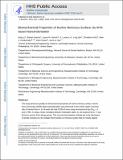| dc.contributor.author | Li, Qing | |
| dc.contributor.author | Doyran, Basak | |
| dc.contributor.author | Gamer, Laura W. | |
| dc.contributor.author | Lu, X. Lucas | |
| dc.contributor.author | Qin, Ling | |
| dc.contributor.author | Rosen, Vicki | |
| dc.contributor.author | Han, Lin | |
| dc.contributor.author | Ortiz, Christine | |
| dc.contributor.author | Grodzinsky, Alan J | |
| dc.date.accessioned | 2017-01-20T19:44:26Z | |
| dc.date.available | 2017-01-20T19:44:26Z | |
| dc.date.issued | 2015-03 | |
| dc.date.submitted | 2015-02 | |
| dc.identifier.issn | 0021-9290 | |
| dc.identifier.uri | http://hdl.handle.net/1721.1/106567 | |
| dc.description.abstract | This study aimed to quantify the biomechanical properties of murine meniscus surface. Atomic force microscopy (AFM)-based nanoindentation was performed on the central region, proximal side of menisci from 6- to 24-week old male C57BL/6 mice using microspherical tips (R[subscript tip]≈5 µm) in PBS. A unique, linear correlation between indentation depth, D, and response force, F, was found on menisci from all age groups. This non-Hertzian behavior is likely due to the dominance of tensile resistance by the collagen fibril bundles on meniscus surface that are mostly aligned along the circumferential direction. The indentation resistance was calculated as both the effective modulus, E[subscript ind], via the isotropic Hertz model, and the effective stiffness, S[subscript ind] = dF/dD. Values of S[subscript ind] and E[subscript ind] were found to depend on indentation rate, suggesting the existence of poro-viscoelasticity. These values do not significantly vary with anatomical sites, lateral versus medial compartments, or mouse age. In addition, E[subscript ind] of meniscus surface (e.g., 6.1±0.8 MPa for 12 weeks of age, mean±SEM, n=13) was found to be significantly higher than those of meniscus surfaces in other species, and of murine articular cartilage surface (1.4±0.1 MPa, n=6). In summary, these results provided the first direct mechanical knowledge of murine knee meniscus tissues. We expect this understanding to serve as a mechanics-based benchmark for further probing the developmental biology and osteoarthritis symptoms of meniscus in various murine models. | en_US |
| dc.description.sponsorship | National Institutes of Health (U.S.) (Grants AR033236) | en_US |
| dc.language.iso | en_US | |
| dc.publisher | Elsevier | en_US |
| dc.relation.isversionof | http://dx.doi.org/10.1016/j.jbiomech.2015.02.064 | en_US |
| dc.rights | Creative Commons Attribution-NonCommercial-NoDerivs License | en_US |
| dc.rights.uri | http://creativecommons.org/licenses/by-nc-nd/4.0/ | en_US |
| dc.source | PMC | en_US |
| dc.title | Biomechanical properties of murine meniscus surface via AFM-based nanoindentation | en_US |
| dc.type | Article | en_US |
| dc.identifier.citation | Li, Qing et al. “Biomechanical Properties of Murine Meniscus Surface via AFM-Based Nanoindentation.” Journal of Biomechanics 48.8 (2015): 1364–1370. | en_US |
| dc.contributor.department | Massachusetts Institute of Technology. Department of Biological Engineering | en_US |
| dc.contributor.department | Massachusetts Institute of Technology. Department of Electrical Engineering and Computer Science | en_US |
| dc.contributor.department | Massachusetts Institute of Technology. Department of Materials Science and Engineering | en_US |
| dc.contributor.department | Massachusetts Institute of Technology. Department of Mechanical Engineering | en_US |
| dc.contributor.mitauthor | Ortiz, Christine | |
| dc.contributor.mitauthor | Grodzinsky, Alan J | |
| dc.relation.journal | Journal of Biomechanics | en_US |
| dc.eprint.version | Author's final manuscript | en_US |
| dc.type.uri | http://purl.org/eprint/type/JournalArticle | en_US |
| eprint.status | http://purl.org/eprint/status/PeerReviewed | en_US |
| dspace.orderedauthors | Li, Qing; Doyran, Basak; Gamer, Laura W.; Lu, X. Lucas; Qin, Ling; Ortiz, Christine; Grodzinsky, Alan J.; Rosen, Vicki; Han, Lin | en_US |
| dspace.embargo.terms | N | en_US |
| dc.identifier.orcid | https://orcid.org/0000-0003-3511-5679 | |
| dc.identifier.orcid | https://orcid.org/0000-0002-4942-3456 | |
| mit.license | PUBLISHER_CC | en_US |
| mit.metadata.status | Complete | |
